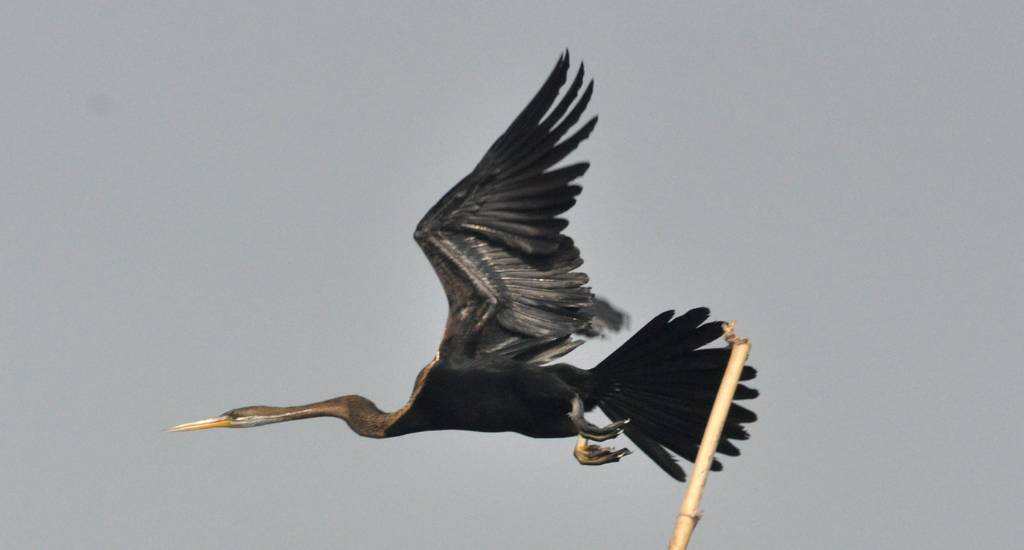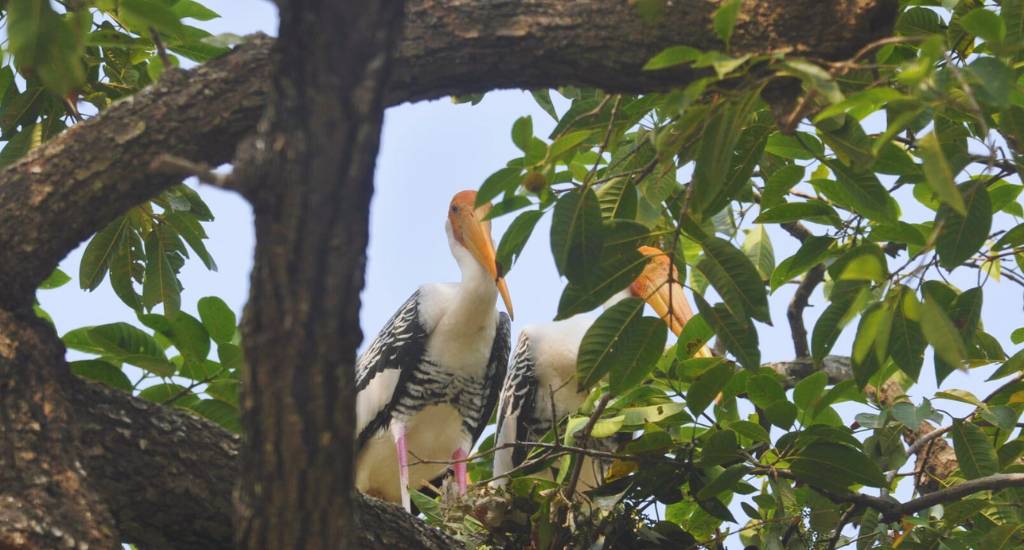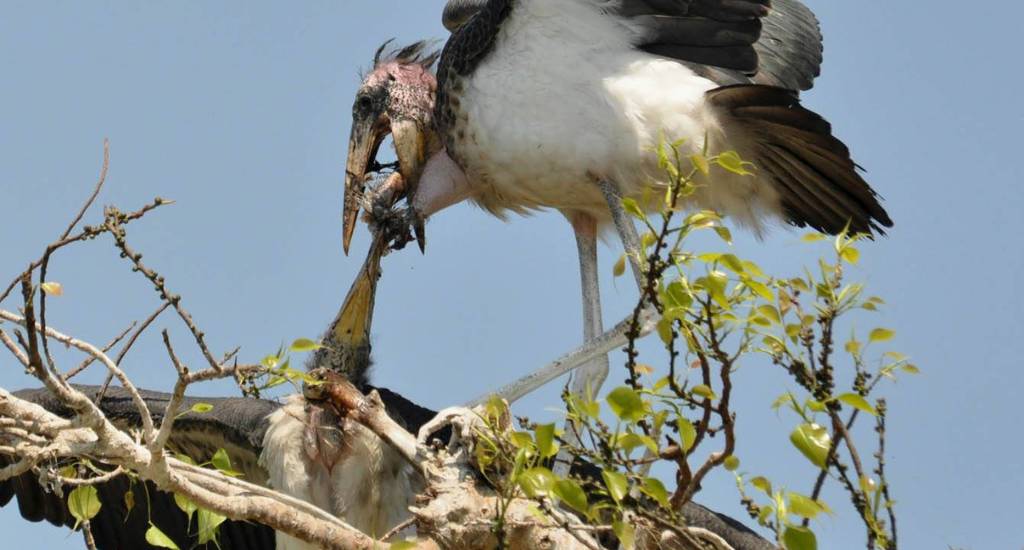In 2007, two nests fell from the top of a tall tree in a leafy neighbourhood in Bihar’s Bhagalpur town. Inside those nests were the fragile eggs of one of the world’s rarest storks, the greater adjutant (Leptoptilos dubius), known locally as the garuda.
These birds were teetering on the edge of extinction. As Arvind Mishra held the fallen nests in his hands, he made a promise to himself: he would dedicate his life to saving this remarkable species.

Back then, the population of greater adjutants in Bhagalpur had dwindled to just 78 birds. Today, thanks to Mishra’s tireless efforts, more than 600 garudas now call this town their home, nesting, breeding and thriving in the wetlands and trees of the region.
“It’s my passion,” said Mishra, now 65, with quiet determination.
The greater adjutant stands about five feet tall and has an eight-foot wingspan. This scavenger is easily recognised by its bald head, large orange neck pouch and awkward gait. Once widespread, the species is now critically endangered due to significant habitat loss, particularly the destruction of wetlands and the deforestation of nesting trees.
Also Read: This Jaipur vet risks his life to save wildlife
Human activities such as agricultural expansion, urban development and pollution have further exacerbated their decline. Negative perceptions of the bird — considered ugly and ominous by many locals — have led to deliberate destruction of nests, further threatening their survival.
Guardian of garuda
Mishra’s journey to save this striking stork actually began a year before those nests fell. As part of the Indian Birds Conservation Network, he discovered that greater adjutants were breeding in Bhagalpur. This was an astonishing find at a time when their numbers were rapidly declining across India.

For Mishra, the greater adjutant’s near extinction was due to two primary factors. The first was the loss of wetlands and trees, the bird’s natural habitat. But the second reason was more deeply ingrained in the local psyche. With its bare head, large neck pouch and awkward gait, it did not embody the grace or melody that other birds might, and its grunty call only added to its unpopular image. Many locals believed the stork was a harbinger of misfortune.
But Mishra was determined to change these perceptions. He set out to educate the villagers about the important role the greater adjutant or garuda plays in maintaining the ecosystem. He explained how these storks feed on snakes and rodents, helping to protect crops from pests. He also tapped into the region’s rich spiritual heritage. Mishra enlisted local priests to spread the word in temples, linking the garuda to Lord Vishnu.
“I told people that disturbing these birds or destroying their nests could bring calamities they had never seen before,” he said.
Stork of luck
Over the years, Mishra’s outreach efforts took root. He trained local doctors and a nurse in handling injured birds and fallen hatchlings, ensuring that the community had the skills to care for the storks when they were most vulnerable. In 2015, he partnered with the state forest department to open the first rehabilitation centre for greater adjutants in Bhagalpur.
Also Read: Yay! We spotted the rare greater scaup duck
“Each season, we help three or four fallen hatchlings survive,” Mishra said. “That may not sound like much, but for a species on the verge of extinction, every bird counts.”

Born and raised in Bhagalpur, Mishra has always felt a deep connection to nature. Growing up surrounded by the wetlands and vibrant birdlife along the Ganga, his love for wildlife took root at a young age.
Though he pursued a career in teaching, his passion for conservation never waned. In the late 1990s, he became involved with local birdwatching groups, and in 2006, he founded the Mandar Nature Club, a non-profit organisation focused on wildlife conservation in Bihar.
The greater adjutant quickly became the symbol of Mishra’s larger mission to protect the region’s fragile ecosystems. He knew that without community involvement, his efforts would be in vain. So he formed groups like the ‘Garud Guardians’ for elders, the ‘Garud Saviours’ for the younger generation, and the ‘Garud Sevika’ group for women. These groups adopted nests, monitored the birds and spread awareness about the importance of conserving the species.
“Women have taken on leadership roles in monitoring nests and ensuring their protection, especially during the breeding season,” Mishra said.
Saving vanishing species
Over time, this collective effort instilled a sense of pride among the villagers, who now see the storks as a vital part of their community.
Watch: Sparrow Saviors of Jeypore: A Tale of Community Conservation

But challenges remain. Shrinking wetlands, agricultural expansion and development projects threaten the storks’ habitat. The birds sometimes mistake plastic waste for food, putting their lives at risk. Climate change has also altered weather patterns, disrupting breeding cycles and increasing the frequency of floods.
Mishra and his team continue to push forward, organising clean-up drives and working to mitigate the effects of these threats. Today, Bhagalpur is home to the second-largest breeding colony of greater adjutants in the world, second only to Assam.
Mishra’s work has earned him numerous awards, including recognition from the Sundervan Rescue and Rehabilitation Centre in 2015 and the Convention on Conservation of Migratory Species in 2020. His model of community-driven conservation has even been replicated in other parts of India.

Yet for Mishra, the true reward is seeing the storks thrive. As the garudas return to their nesting trees in Bhagalpur during the monsoon, the sight of these giant birds soaring over the wetlands brings him immeasurable joy.
“Protecting their wings,” Mishra asserted, “means protecting our future.”
Also Read: Guardians of the hoolock gibbons of Hollongapar
The lead image on top shows a pair of greater adjutant storks, locally called garuda in Bhagalpur. (Photo courtesy Arvind Mishra)
Kumar Gaurav, a Village Square Fellow 2023-24, is a multilingual audio-visual journalist based in Bihar.








